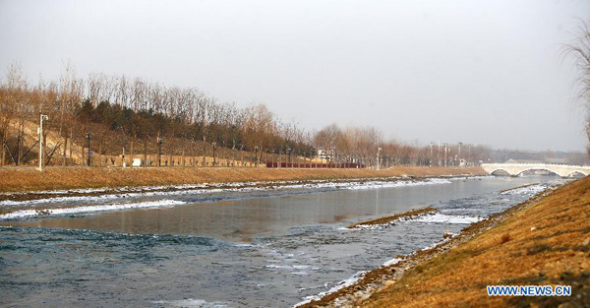

Photo taken on Dec 27, 2014 shows water flowing after the opening of a sluice gate of the middle route of the south-to-north water diversion project in Beijing, capital of China. (Xinhua/Yin Gang)
About five million Beijing residents are now drinking water from a tributary of the Yangtze River, two months after a key section of China's massive south-to-north water diversion project was put into operation.
Beijing has received more than 50 million cubic meters of water from the south since Dec. 12, when water began to be routed from the central Chinese province of Hubei to the capital, said the Beijing south-to-north water diversion office on Thursday.
The first stage of this middle route -- one of three routes involved in the project -- starts at Hubei's Danjiangkou Reservoir, which stores water from the Hanjiang River, a tributary of the Yangtze River.
A 1,432-km-long canal brings the water to China's thirsty northern regions, including the cities of Beijing and Tianjin, and the provinces of Henan and Hebei.
The amount of water flowing along the middle route is expected to increase from the current 9.5 billion cubic meters to 13 billion cubic meters by 2030.
Two out of the six water plants in Beijing are using the "southern water" as their sole source. The other plants are mixing the southern water with domestic water.
As of Thursday, all of the 159 facilities established across Beijing to test the water from the south showed the city's tap water was meeting national standards.
Beijing is expected to double its daily consumption of the southern water to 1.7 million cubic meters by the end of May. The city is projected to consume 818 million cubic meters of water, nearly a quarter of its annual consumption, from the south by the end of October.
With a population of over 20 million, Beijing consumes 3.6 billion cubic meters of water annually, but its water resources per capita are only one-eightieth of the world average.
The capital's water supply previously relied heavily on groundwater, but its high calcium and magnesium content irritated residents by clogging showerheads and stiffening laundry.
China's south-to-north water diversion project, the world's largest such scheme, is designed to take water from the country's longest river, the Yangtze, through eastern, middle and western routes to supply dry areas in the north, including Beijing.
It was officially approved by the State Council, China's cabinet, in 2002, 50 years after late Chinese leader Mao Zedong came up with the idea.
The project, with an estimated total cost of 500 billion yuan (about 81.6 billion US dollars), started with the construction of the eastern route in 2002 and the middle route in 2003. The western route, which requires more sophisticated technology, is still in the research stage.
Upon completion, the project is expected to divert up to 44.8 billion cubic meters of water per year to more than 10 provinces and cities, benefiting nearly 100 million people. Up to 600,000 jobs are also estimated to be created.
The 1,467-km-long eastern route starts in Jiangsu Province at the Yangtze River and runs through Anhui and Shandong provinces. It started supplying water in December 2013.
Copyright ©1999-2018
Chinanews.com. All rights reserved.
Reproduction in whole or in part without permission is prohibited.